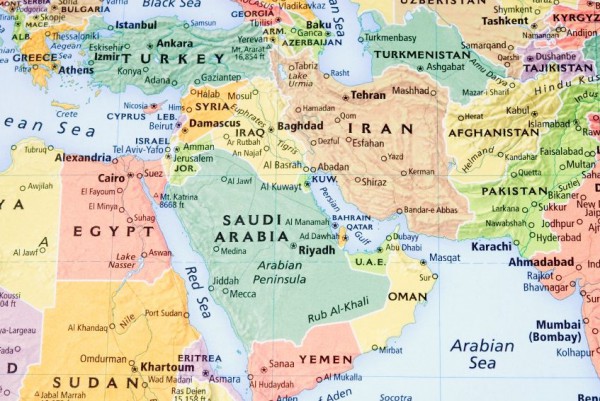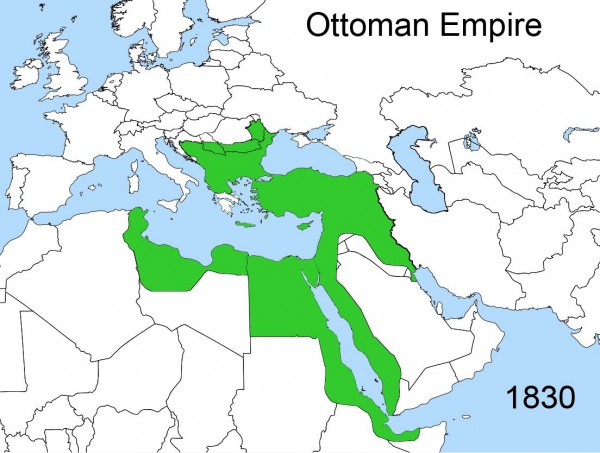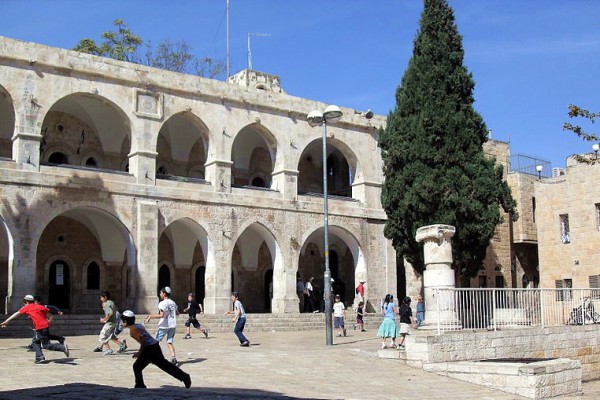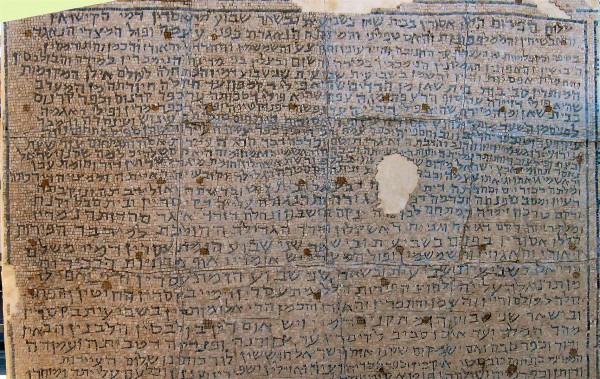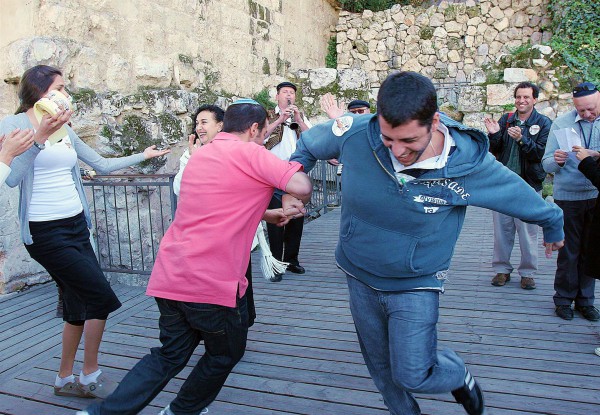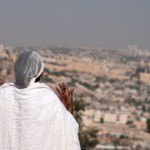“The whole land of Canaan, where you now reside as a foreigner, I will give as an everlasting possession to you and your descendants after you; and I will be their God.” (Genesis 17:8)
The Holy Land, promised to Abraham by Adonai, has a recorded history that stretches over thousands of years. Despite that history, the Promised Land is today one of the most contested areas of the Earth.
This was not always the case. Jews, Christians, and Muslim all recognized the Jewish history of Israel, Jerusalem, and the Temple Mount years before an alternate history was created in the 20th century.
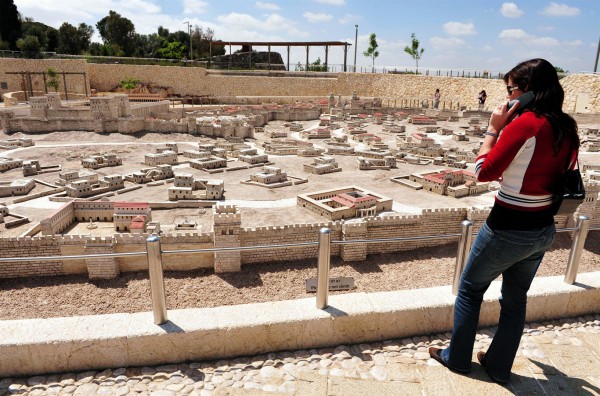
A woman examines a model of what the Temple Mount (upper left hand corner) and Jerusalem would have been like during the Second Temple period.
As recently as 1924, the Supreme Muslim Council, which controlled the Temple Mount area, published its first English-language tourist guide which stated:
“The site is one of the oldest in the world. Its sanctity dates from the earliest times. Its identity with the site of Solomon’s Temple is beyond dispute. This, too, is the spot, according to universal belief, on which David built there an altar unto the Lord, and offered burnt offerings and peace offerings.” (A Brief Guide to al-Haram al-Sharif)
Even with this admission of the Jewish connection to the Land, the guide made it clear that the Jewish and Christian narrative had now evolved into the Muslim narrative. Islam claims to reveal the final chapter of God’s eternal plan for mankind.
Coupled with that sentiment is the belief that the Land and all holy sites now rightfully belong to the Muslims. But since that is not a strong enough claim to the Land, a new narrative has since been written that disputes Jewish history in the Holy Land.
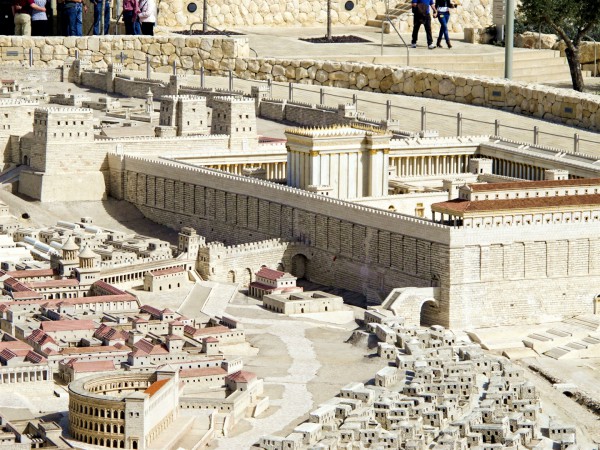
This model of how Jerusalem is believed to have looked in AD 66 shows that the Western (Wailing) Wall of the Temple Mount was the wall closest to the Temple itself. (Photo by Dan Lundberg)
The Land Is Mine
“The land must not be sold permanently, because the land is Mine and you reside in My land as foreigners and strangers.” (Leviticus 25:23)
Though Israel is no bigger than the state of New Jersey, it is the most contested area in the world. According to Leviticus 25:23, however, Adonai retains ownership of the Holy Land.
As owner, He has every right to determine who will live there and He promised it to Abraham. When Abraham entered the Land in obedience to God’s call, He promised that the land would belong to him and his descendants as an everlasting possession.
“The whole land of Canaan, where you now reside as a foreigner, I will give as an everlasting possession to you and your descendants after you; and I will be their God.” (Genesis 17:8)
As well, Scripture assures us that God’s eyes are always on the Holy Land: “The land you are entering to take over is not like the land of Egypt, from which you have come, … It is a land the Lord your God cares for; the eyes of the Lord your God are continually on it from the beginning of the year to its end.” (Deuteronomy 11:10, 12)
Moreover, He guards both the Land and His people:
“Rejoice, you nations, with His people, for He will avenge the blood of His servants; He will take vengeance on His enemies and make atonement for His land and people.” (Deuteronomy 32:43)
In Deuteronomy 7:1, Moses tells the children of Israel that God Himself would drive the people out of the Land. He reassures them that though the nations living in the Land are “larger and stronger than you,” “the LORD your God brings you into the land you are entering to possess and drives out before you many nations.”
Because they were afraid and refused to enter the Land, they had to wander 40 years in the wilderness. When they finally entered the Land, God commanded them to dispossess the people.
Disputing God’s Promises
Disputers of the Jewish claim to this Land raise arguments of all kinds to undercut the connection of both the modern state and the ancient tribes to the Land of Promise.
Some question if God had the right to remove people from one place in order to give it to another. Others mistakenly believe that Abraham stole the Land from the Canaanites; however, Abraham’s descendants only took possession of the Land after they left Egypt.
To strengthen the Palestinian claim to the Promised Land, some have unjustifiably claimed that the present-day Palestinians are the descendants of the ancient Canaanites and the Jewish People stole their land.
For instance, in May of 2015, PA Deputy Minister of Jerusalem Affairs and member of Fatah’s Revolutionary Council Salwa Hadib declared on official PA TV that Jerusalem “has been a Canaanite city for thousands of years. The Palestinian people has been present in it for thousands of years, whether it was in Babylon, Assyria or Canaan, they [the Palestinians] gathered in the area before anything else, centuries before the Jewish religion….”
In reality, those who call themselves Palestinians today are a mixed ethnic group.
“In 1882, fewer than 250,000 Arabs lived there, and the majority of them had arrived in recent decades. Palestine was never an exclusively Arab country,” writes Mitchell Bard in the article “Pre-State Israel: The Jewish Claim to the Land of Israel.”
Many Palestinians today are actually descendants of people who came from Bosnia, the Balkans, Caucasus, Arabian Peninsula, Sudan, Egypt, Syria, and Lebanon. A great number came to Israel during the British Mandate to find work.
Origins are traceable through Arabic last names, which are largely identifiable with clans, tribes, and nationalities.
Arabs living in the land before the British Mandate had no united nationalism because they were part of the Ottoman Empire (1517–1917).
In February 1919, Palestinian-Arabs in the First Congress of Muslim-Christian Associations stated, “We consider Palestine as part of Arab Syria, as it has never been separated from it any time. We are connected with it by national, religious, linguistic, natural, economic and geographical bonds.”
In Palestinian Identity: The Construction of Modern National Consciousness, Khalidi Rashid explains that the Palestinian people read into the history of Palestine “a nationalist consciousness and identity that are in fact relatively modern.”
After the Ottoman Empire ended its 400-year rule of the land in 1920, the name “Palestine” emerged as a general geographic term, which continued beyond World War I under the British Mandate period.
Arab Palestinians did not initially embrace the term Palestine.
In fact, in the 1930s and ’40s, various Arab voices rejected the term Palestine as an invention of the Zionists.
“Leading up to Israel’s independence in 1948, it was common for the international press to label Jews, not Arabs, living in the mandate as Palestinians,” writes Jewish Virtual Library. “It was not until years after Israeli independence that the Arabs living in the West Bank and Gaza Strip were called Palestinians.”
In truth, the title of “Palestine” for the Promised Land originated in the 2nd century AD.
In AD 135, the Roman emperor Hadrian renamed the region called “Provincia Judea” to “Provincia Syria Palaestina” — a name that refers in part to the ancient Jewish enemies, the Philistines.
Renaming the land was an attempt to completely wipe out the name of Israel. Merely changing the name of the land to Palestine, however, did not make a new nation or a new ethnicity called the Palestinians.
Digging for the Truth About Jewish History
While the Bible is an excellent source of history, can the Jewish connection to the Land of Israel be proved independently of the Bible?
Archaeological evidence confirms that it can.
Richard Elliott Friedman, the Ann and Jay Davis Professor of Jewish Studies at the University of Georgia, points out that thousands of ancient Hebrew inscriptions have been found throughout the Land of Israel. (Aish)
“They come from hundreds of excavated towns and cities. They are in the Hebrew language. They include people’s names that bear forms of the name of their God: YHWH,” Friedman writes. “They reflect a widespread community whose dominant language was Hebrew, who didn’t eat pork and who worshiped a God named YHWH.”
Friedman also said he witnessed firsthand the excavation of a 7th century BC tomb in Jerusalem below the Church of Scotland that bore the Priestly Blessing given to the sons of Aaron.
The tomb epitaph reads: “May YHWH bless you and keep you. May YHWH make His face shine to you and give you peace.”
Other Hebrew inscriptions have been found that refer to the kings of Israel, such as David and Solomon, including stamps and seals like the King David Era seal found by Russian 10-year-old Matvei Tcepliaev while sifting dirt taken from the Temple Mount itself.
Yet, even these facts are denied by top officials like Hadib, who also declared on PA TV:
“An Israeli engineer and an archaeologist brought Israeli coins — shekels and agoras — and threw them on the ground before the renovation [of the Al-Karmi neighborhood in Jerusalem] in order to prove, after dozens and hundreds of years, that ‘we (i.e., the Israelis) were present here.’ They are stealing history and geography.” (PalWatch)
And even though the Muslim Council once acknowledged that the Temple Mount was indisputably the site of Solomon’s Temple, when the Jordanian Supreme Awaqf Council (Waqf) gained administration of the Mount after the war of Independence in 1948, Jewish heritage was denied.
In the revised 1954 edition of “A Brief Guide to al-Haram al-Sharif,” published by the Waqf, no mention is made of the First and Second Temples or Jewish veneration for the site.
“In taking historical control, by discrediting and dismissing Jewish connections to the site, and [by taking] physical command over the Haram al-Sharif and Jerusalem, the Supreme Awqaf Council legitimized their rule and channeled national sentiment,” a thesis by Jennifer Koshner states. (Palestine’s Sacred Struggle, p. 49)
This relatively new nationalistic pursuit by Arabs has fueled intifadas and worldwide sympathies for a national Palestinian homeland, even though their claim to the land has no validity.
Divine Ownership and Human Inheritance
“The earth is the Lord’s, and everything in it, the world, and all who live in it; for he founded it on the seas and established it on the waters.” (Psalm 24:1–2)
So who really owns the land within Israel’s borders and the Temple site where God’s Shekhinah glory once dwelled, and who really owns Jerusalem, where God chose to put His Name?
God remains sovereign over His Creation; still, the Most High has given all “the nations their inheritance.” (Deuteronomy 32:8)
To the descendants of Abraham through Isaac and Jacob, He gave the Land of Israel.
“I am the Lord, the God of your father Abraham and the God of Isaac. I will give you [Jacob] and your descendants the land on which you are lying. Your descendants will be like the dust of the earth, and … all peoples on earth will be blessed through you and your offspring.” (Genesis 28:13–14)
Adonai is so clear about who gets the land of Israel as an inheritance that the prophet Jeremiah conveys God’s oath to “uproot from their lands” those among “all my wicked neighbors who seize the inheritance I gave My people Israel.” (Jeremiah 12:14)

These ruins at the base of the Temple Mount wall include stones that the Romans toppled from the Temple Mount above.
Although Adonai gave His own chosen property to Abraham and his descendants as an “everlasting possession,” He says He will remove them from the land if they fall into sin. He also promises to return them.
“But after I uproot them, I will again have compassion and will bring each of them back to their own inheritance and their own country.” (Jeremiah 12:15)
True to God’s Word, the Jewish People were removed and then returned to the Land; despite that, a remnant has always remained in the Holy Land.
“In reality, the Jewish people have maintained ties to their historic homeland for more than 3,700 years,” Mitchell Bard writes in the article “Pre-State Israel: The Jewish Claim to the Land of Israel.”
“Even after the destruction of the Second Temple in Jerusalem and the beginning of the exile in the 6th century BC, Jewish life in Palestine continued and often flourished,” Bard notes.
Despite widespread persecution, “large communities were reestablished in Jerusalem and Tiberias by the ninth century. In the 11th century, Jewish communities grew in Rafah, Gaza, Ashkelon, Jaffa and Caesarea,” Bard writes, adding that the Crusader massacres of the 12th century were not all-destructive, either: Jewish communities continued to grow in the Land over the next few centuries and 10,000 Jews lived in the Land by the early 1800s.
By 1920, about 60,000 Jews lived in the Land. The population increased to over 800,000 Jews by 1948. Today, around 7.1 million Jewish people live in Israel.
The Redemption of the Land
God established the inheritance and the boundaries of not just the nations, including Israel, but also each of the 12 tribes of Israel — and of individuals within each tribe.
The children of Israel who had settled in their promised inheritance could sell or lease parcels of land, but it could not be permanent. In the Jubilee year, everyone was to return to his own property. (Leviticus 25:8–55)
Moreover, the land could be redeemed by the Israelite who owns it or by a relative.
“Throughout the land that you hold as a possession, you must provide for the redemption of the land.” (Leviticus 25:24; see also 25:47–55)
For every people group and every individual, God has set an inheritance — a gift that is irrevocable; for the Jewish People, that gift is the Holy Land.
We see this principle at work in the salvation made possible through Yeshua (Jesus). For those who are the brothers and sisters of Yeshua through adoption, He has bought back their inheritance and redeemed their land.
So committed is Adonai to our inheritance that He promised punishment in the end days to those who would divide up “My Land.” (Joel 3:2)
God’s concern for His Land and His people reminds us that He does not forget or neglect His promises to us over the course of time. He is faithful and His promises will not fail, though principalities and powers oppose them.
And while a false narrative misleads the world regarding the heritage of the Jewish People, in these Last Days we will continue to see God fulfill His purposes among His people—the physical restoration of the Holy Land and the spiritual restoration of the Jewish People.





